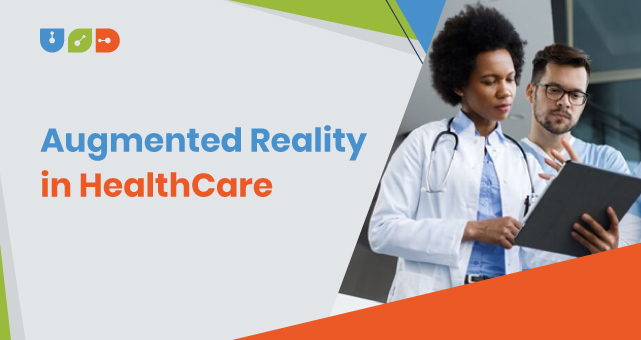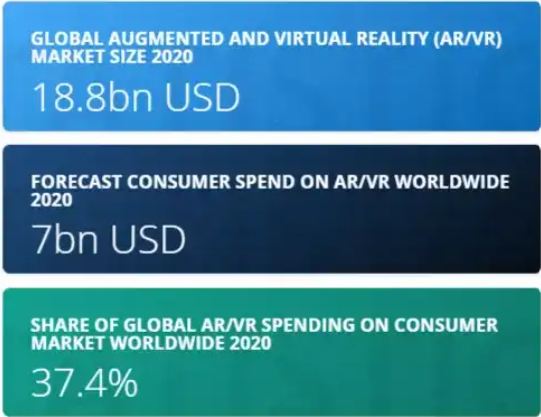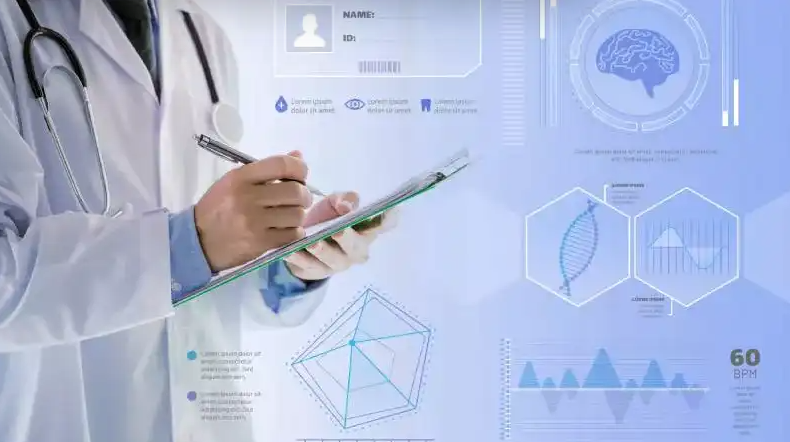Table of Contents
ToggleAugmented reality (AR) extends beyond the realm of gaming and is making significant strides in healthcare. Indeed, AR in healthcare is opening doors to a future filled with boundless potential.
AR in healthcare is often associated with futuristic headgear and science-fiction concepts and is poised to revolutionize the way patients experience medical care. The upcoming generations of AR are expected to introduce even more remarkable advancements, promising meaningful journeys within AR in healthcare.
For healthcare organizations eager to stay informed about this thriving technology, you’ve come to the right place. This blog will delve into some of the most noteworthy AR VR apps in healthcare. Let’s explore!
Advancements in Augmented Reality—Critical Insights
Before we delve into the promising applications of augmented reality in healthcare, it’s essential to consider some key facts:
Gartner suggests that 5G mobile network technology presents a significant opportunity to expedite the adoption of AR.
Gartner’s 5G enterprise survey has revealed that AR VR application Development of 5G hold the highest expectations and are catalysts for new revenue generation across various use cases and among respondents.
According to Forrester, AR is expected to become commonplace by 2021, while VR will likely remain a niche technology.
Zion Market Research forecasts that the Global Healthcare AR VR market will achieve a substantial value of USD 5,115 Million by 2025, with an estimated compound annual growth rate (CAGR) of approximately 29.2% between 2019 and 2025.
Experts also project that the AR market will expand to a valuation of 18 billion USD by 2023.
Here’s a brief glimpse into the size and potential of the AR VR market.
The importance of augmented journeys is apparent, but the pivotal question is: What implications does this hold for your healthcare institution? How can your healthcare organization leverage the augmented reality journey for its benefit?
Let’s explore these questions.
Prospects for Augmented Reality in the Healthcare Sector
The emerging applications of AR in the healthcare field hold the potential to elevate patient care. How?
To begin with, AR can empower physicians to make more precise diagnoses and treatment decisions by providing access to real-time patient data.
The innovative applications of AR in the healthcare industry are groundbreaking. Let’s explore some of these fresh opportunities.
1. Augmented Surgery
Envision the potential of Augmented Reality (AR): Surgeons gain the ability to visualize patients’ bones and internal organs without the need for invasive procedures. It’s a remarkable advancement, isn’t it?
Surgeons now have access to real-time, life-saving patient information that can be invaluable during both complex and routine medical procedures.
Here’s how it works:
Surgeons can employ AR technology to thoroughly study a patient’s anatomy. They can input MRI and CT scan data into an AR headset, allowing them to superimpose specific patient anatomy onto the patient’s body before surgery.
This process enables surgeons to visualize muscles, bones, and internal organs without the need for any incisions. With AR, surgeons can conduct precise and minimally invasive surgeries, ultimately saving valuable time.
For instance, at hospitals like Imperial College and St. Mary’s Hospital in London, medical professionals have already begun utilizing Microsoft’s HoloLens AR glasses during reconstructive surgeries for patients who have suffered severe injuries.
2. Augmented Diagnosis
You’ve likely noticed that certain patients struggle to convey their symptoms accurately to medical professionals. However, with the integration of Augmented Reality (AR), patients will have a more effective means of expressing their symptoms. This streamlined process will significantly assist doctors in comprehending their patients’ symptoms and providing precise diagnoses.
Here’s a scenario to illustrate this:
Consider a patient visiting a healthcare provider for a necessary injection. With the implementation of AR in healthcare, nurses can now locate veins with greater ease. How does this work? Utilizing innovative solutions like AccuVein, an AR startup employing a handheld scanner, nurses can precisely pinpoint the location of veins, ensuring a smoother and more efficient procedure.
3. Augmented Practice
What occurs when medical students encounter errors during real-life procedures? Indeed, the consequences can be severe. Nevertheless, the integration of AR technology can bring about a revolution in the field of medicine and education, addressing this challenge.
Medical institutions are progressively incorporating AR into their educational programs, offering students invaluable hands-on learning opportunities. Through AR in education, the ability to simulate patient and surgical scenarios becomes more accessible, enabling medical students to visualize and practice theoretical concepts as part of their training.
Here’s a scenario to illustrate the concept:
By utilizing AR applications, students can access overlay anatomy data on a 3D human skeleton. This visualization aids in enhancing their comprehension of how the human body functions, contributing to a more effective learning experience.
Practical Use Cases of AR in Healthcare
AR applications in healthcare extend beyond AR glasses. Presently, physicians are harnessing AR technology with remarkable effectiveness during interventional procedures, including the visualization of paths created by Computerized Tomography (CT) and Magnetic Resonance Imaging (MRI).
Furthermore, AR is experiencing a growing presence in medical education. Thus, the potential is boundless, promising an engaging and exhilarating journey.
Now, let’s delve into some notable real-life instances that demonstrate how AR applications are enhancing the medical experiences of patients.
1. Augmented Reality Showing Defibrillators Nearby & Saving Lives
Imagine this scenario: a loved one suddenly collapses next to you. What would your immediate reaction be? Undoubtedly, after managing the initial rush of emotions, your instinct would be to seek assistance. Perhaps you’d think of contacting a doctor, calling an ambulance, or reaching out to friends for help.
Now, here’s an intriguing alternative to consider: alongside the standard emergency numbers on your phone, you could download the Layar reality browser and complement it with the AED4EU app. In the event of a similar situation, this combination can empower you to provide more effective assistance.
A remarkable individual named Lucien Engelen, who was associated with the Radboud University Nijmegen Medical Centre, developed AED4EU. This innovative application allows users to pinpoint the locations of automated external defibrillators (AEDs). What’s even more impressive is that healthcare professionals can access the AED database through this new application.
Additionally, with the Layar browser, you can project the precise locations of the nearest AEDs onto your phone’s screen. This means that within just a few minutes, you can locate these life-saving devices and extend a helping hand to those in need.
2. Enhancing Physician Collaboration Through Augmented Reality
Consider a scenario where the primary surgeon is situated miles away. In such situations, augmented reality (AR) can provide a valuable solution. If a specialist equipped with AR tools is present on-site, they can receive and follow instructions, offering essential assistance when the primary surgeon is not physically present.
Doctors can employ AR for collaborative surgeries and conduct efficient medical discussions via AR-enhanced video conferencing. This capability can be life-saving, as it enables specialists located at a considerable distance from the clinic to provide crucial support when needed.
3. Google Glass: An Aid for Guiding New Mothers in Breastfeeding
Google Glass can be a valuable tool for providing assistance to mothers who may be encountering challenges with breastfeeding.
Small World, an innovation company based in Melbourne, conducted a trial using Google Glass in collaboration with the Australian Breastfeeding Association. During this trial, telephone counselors had the ability to see what mothers were experiencing as they breastfed their babies at home through the eyes of the mothers themselves.
This unique perspective allowed counselors to offer expert guidance to mothers in need, all while the mothers remained able to hold their babies in their arms—a truly remarkable aspect of this technology.
4. Augmented Reality: Enhancing Patients’ Symptom Description
Accurate diagnosis heavily relies on precise symptom descriptions. It’s a common observation that patients often encounter difficulties when attempting to convey their symptoms accurately. Such challenges can potentially lead to misdiagnosis.
Now, let’s delve into the application of Augmented Reality in Ophthalmology, where this technology can significantly aid patient education. An illustrative example is the medical app EyeDecide, which leverages the device’s camera display to create simulations illustrating the impact of specific eye conditions on an individual’s vision. With apps like EyeDecide Doctors, medical professionals can now provide patients with a visual simulation of what their vision would be like when affected by a particular condition, such as Cataracts or AMD.
This visual representation empowers patients to better comprehend their symptoms and gain insights into their actual medical condition. By grasping the long-term effects of their lifestyle choices on their health, patients are more likely to make positive changes.
5. Augmented Reality: Facilitating Vein Location for Nurses
AccuVein, a pioneering startup, has harnessed the power of Augmented Reality (AR) to benefit both nurses and patients significantly. How does it work? The challenge of locating veins, especially during intravenous injections (IVs), is well-known, with many patients requiring multiple attempts, particularly children and the elderly.
AccuVein has introduced augmented reality through a handheld scanner that projects a visual overlay onto the skin, providing nurses and physicians with precise vein locations within patients’ bodies. According to Vinny Luciano, a marketing specialist at AccuVein, this technology has been employed in the care of over 10 million patients. The AR application enhances the likelihood of successful vein location on the first attempt by a remarkable 3.5 times.
6. Pharmaceutical Firms Can Present Creative Drug Information
Picture diving into the intricacies of drug descriptions that often appear mundane and perplexing. It doesn’t sound particularly engaging, does it? Yet, wouldn’t it be intriguing to comprehend how a medication functions within your body? How can you explore the realm of pharmaceuticals and derive enjoyment from it? The solution lies in Augmented Reality (AR).
Thanks to AR technology, patients now have the opportunity to witness the mechanisms of drug actions in 3D. How does this work? With the assistance of AR, patients can delve into the workings of various drugs, gaining a clearer understanding of their effects. Additionally, laboratory personnel can employ AR equipment to monitor and enhance their experiments.
7. Hololens: Revolutionizing the Study of Anatomy
Wouldn’t it be wonderful to have an accessible and immersive means of visualizing the intricacies of the human body? Well, the good news is that this is now a reality! Case Western Reserve University and the Cleveland Clinic, in collaboration with Microsoft, have introduced an application for HoloLens called HoloAnatomy, offering a remarkable and simplified way to explore the human body.
Utilizing the Microsoft HoloLens headset, users of the app can observe everything from muscle structures to the tiniest veins through a dynamic holographic model. Such applications have the potential to rapidly transform medical education as students gain the ability to visualize the human body in three-dimensional detail.
8. Facilitating Children’s Understanding of the Human Body
Curiscope, a UK-based company renowned for creating immersive learning experiences, has developed the Virtuali-tee T-shirt. You might wonder why kids would be so enthralled by a T-shirt. Here’s the captivating aspect—this T-shirt allows them to explore the inner workings of the human body through lifelike holograms.
Virtuali-tee brings the study of anatomy to life in a way that’s engaging and enjoyable for children, transforming the process of discovering the intricacies of the human body into a fun and exciting adventure.
As you can see, numerous instances of AR in healthcare are already making a significant impact. Augmented reality is set to continually deliver value to healthcare organizations and enhance patient care. The key lies in your exploration of new business processes and discovering how AR can be employed to enhance your systems.
Should you find yourself overwhelmed by this prospect, consider seeking assistance from an expert developer, such as Unique Software Development, who can guide you in crafting a meaningful AR journey for your organization.
9. Improving Patient Engagement in Consultations
The adoption of augmented reality within the healthcare sector offers benefits not only to healthcare professionals but also directly enhances the patient experience. Immersive technologies like augmented and virtual reality have shown tangible improvements in learning processes, and this recognition is extending to patient education regarding their medical conditions. By incorporating AR to augment patient consultations, individuals can now access more comprehensive and informed insights, revolutionizing the way medical information is conveyed during consultations.
Yan Fossat, Vice President of Klick Labs at Klick Health, highlights the significance of this approach by stating, “Empowering someone to instantly visualize a disease or condition on their own skin or enabling them to perceive the world through the eyes of someone with, for instance, macular degeneration has a more profound impact compared to other forms of visual or textual representation.”
Embarking on Your Augmented Reality Journey: Time for Planning
As an innovative entrepreneur, taking crucial steps to introduce or integrate augmented reality (AR) into your systems and workflows is essential.
To ensure a seamless transition, engage your team in brainstorming sessions aimed at identifying optimal points for integrating AR with your existing technologies. You can also strategize the selection and optimization of AR applications, along with providing comprehensive training and upskilling opportunities for your workforce.
However, a word of caution is necessary—when implementing AR, it’s vital to meticulously plan for the security of patient data. The use of wearables may introduce data privacy concerns, necessitating the development of a comprehensive security strategy.
Finally, brace yourself to explore the dynamic realm of augmented reality. Select applications that can enhance the overall medical experience for patients while streamlining your healthcare operations.
Creating a Purposeful Augmented Reality Expedition
If you aspire to design a purposeful AR journey that can enhance the overall medical experiences of patients, don’t hesitate to contact us.
We are a distinguished web and mobile app development company recognized for our extensive expertise in crafting exceptional digital success stories across various industries. Let’s engage in a conversation.



















